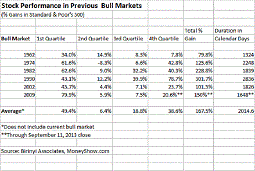Last week, MoneyShow's Howard R. Gold sat down with noted market historian Laszlo Birinyi, after a two and a half year absence to hear his current thoughts on the market and you may be surprised by their exchange.
When I last interviewed noted market historian Laszlo Birinyi back in February, 2011, he was one of a very few big-name gurus who said we were in a genuine bull market that could last for years.
I caught up with Birinyi, the president of Birinyi Associates, Inc. in Westport, Connecticut, again last week, two and a half years later, just before the Standard & Poor's 500 Index posted its strongest winning streak since mid-July in the normally dismal month of September.
As of Wednesday, the S&P hovered near its recent all-time high above 1,700. That number was right around Birinyi's “worst case” target from 2011.
- Read Howard's earlier commentary on Birinyi's bull market call on MoneyShow.com.
So, is he declaring victory? Not yet. Though he's a little cautious for the short term, he thinks the current bull market—which many investors still don't accept—ain't over yet.
“I think the bull market continues,” he told me. “I think we will be over 2,000 before it's over.”
How does it get there? As a market historian, he compares this market to five other major bull markets over the last half century.
As the table below shows, they ranged from the relatively brief Kennedy bull market of 1962, which lasted slightly more than 3.5 years and returned 79.8%, to the monster bull of the 1990s, which went on for nearly eight years and saw the S&P quadruple.
The average return of those five bull markets was 167.5%. The current bull's gain of 150% is close to that, but at 4.5 years, it has lasted a year less than the recent bull market average. Birinyi thinks this bull still has the juice to keep going.
He says bull markets go through four phases of sentiment: reluctance, digestion or consolidation, acceptance, and finally exuberance. Of course, you can't precisely measure those phases until the bull market is over, but Birinyi says the current bull entered phase four in July, 2012. Since then, the S&P has risen 22%.
The exuberance has a funny way of showing itself—Consensus, Inc.'s Bullish Sentiment index of professional investors has fallen to 50% from 67% in early August, while the American Association of Individual Investors' poll last week showed a narrow 35%-31% split between bulls and bears.
But Birinyi thinks investors have only begun to dump bonds and warm to US stocks. In fact, he says, the lack of obvious euphoria may actually extend this bull market's life.
NEXT: Is the party almost over?
|pagebreak|
“If you look historically, the first and last phases are where you make most of your gains,” he told me. “We still have the potential for a good rally.”
But is the party nearly over? “It's the beginning of the end, but if you go back to 1999…we still had tremendous moves,” Birinyi told me.
We're at the point now, he said, where reluctant investors have started to jump in again, but so far that news has been confined to the financial pages.
“We still haven't gotten to the [year] 2000" level of euphoria, he said. “I think once you get to the point where you have a page-one story, that's where you get a good surge.” Or maybe when it makes the cover of Time magazine.
“That's what I call capitulation...., which I see at market tops” as well as bottoms, he said. And because we haven't seen it yet, does that mean the bull market could go on for another year or two?
“I think it could,” he told me.
And consider this: The S&P needs to gain only 18% more to reach 2,000. The Dow Jones Industrial Average is a more distant 30% away from the even more magical number of 20,000, which would almost certainly prompt many fence sitters to jump back into stocks.
But if the S&P hits 2,000, that would mean a total market gain of 195.6% from its March, 2009 closing low of 676.53, putting this bull market among the very best of the last 50 years.
Back in 2011, Birinyi said S&P 2,800 was the “best case” and 2,100 a “more probable” scenario—by September, 2013. Well, here we are, and we certainly have achieved his worst case, 1,750. If we give it another year, who knows? Birinyi went way out on a limb, and by any measure, it was a great call.
- Watch Howard's recent video with Birinyi about hot and cold sectors on MoneyShow.com.
He's no longer a voice in the wilderness. Craig Johnson of Piper Jaffray, who said the S&P would hit 1,700 this year, is calling for 2,000 in 2014. Goldman Sachs and Deutsche Bank say it will cross the 2,000 mark by 2015.
I don't know if it will, but except for some occasional short-term profit taking, I'm sticking to my target stock allocation for now. If the S&P hits 2000, I'll reassess. But if Birinyi continues to be right, that may happen sooner than I expect.
Howard R. Gold is editor at large for MoneyShow.com and a columnist for MarketWatch. Follow him on Twitter @howardrgold or for more upcoming Moneyshow show information, click here.






















